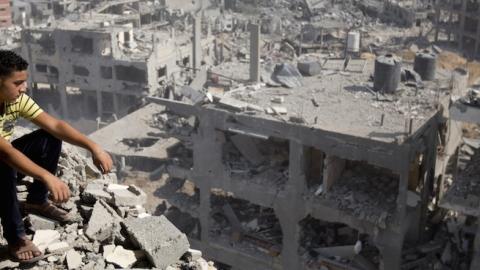Now into its second day, the 72-hour humanitarian ceasefire between Israel and Palestinian factions continues to hold. With Hamas’ missile arsenal depleted by roughly 50 percent and, according to Israeli assessments, 32 attack tunnels destroyed, Israeli officials are claiming a clear victory. “The IDF won big time in Gaza,” says one commander of an elite unit. “Stop staying we lost. We won.”
Jerusalem’s efforts now will be focused on how to demilitarize the Gaza Strip and prevent Hamas and its allies, like Palestinian Islamic Jihad, from rearming and rebuilding its attack tunnels. Neither will be easy.
While Egyptian president Abdel Fattah al-Sisi has demolished many of the smuggling tunnels leading from Sinai to Gaza, the reality is that smuggling is a central component not only of Gaza’s economy, but also Sinai’s. Unless Cairo can come to an accommodation with the Sinai Bedouins with whom it has frequently been at war over the last year, then a certain amount of weapons, if only a fraction, will get through. Iran will see to it. “The Muslim world has a duty to arm the Palestinian nation by all means,” Supreme Leader Ali Khamenei said recently, underscoring the fact that Hamas’s most tangible victory over the last three weeks is to have repaired relations with the Islamic Republic.
However, given the stunning success of Israel’s anti-missile defense system, the attack tunnels are an even more serious concern, demanding a sort of subterranean Iron Dome stopping Hamas fighters from entering Israel. To that end, Israel is developing various forms of tunnel detection technology, like one system that listens for digging. Another Israeli company proposes digging a long tunnel along the Israel-Gaza border. In effect, it’s an underground moat, according to the company’s CEO, that "will provide real-time alerts of any tunnel digging that crosses our tunnel, whether above or below it.”
If Israel won handily, the reality is that Hamas is still in place. As Jonathan Spyer, a frequent Weekly Standard contributor, explains in his recent article Netanyahu’s ‘Long War’ Doctrine, Jerusalem had only two choices. “The first involved seeking to inflict serious damage on Hamas’s military capabilities in an operation limited in scope,” writes Spyer. “The second, more ambitious option would have been to have pushed on into the Gaza Strip, and to have destroyed the Hamas authority there.”
The problem with the second, Spyer explains, is that it would have “required Israel to re-establish the civil administration in Gaza, taking responsibility for the lives of the 1.8 million residents of the Strip. This is because it would be politically impossible for the Ramallah Palestinian Authority to receive the Gaza Strip on a silver platter, as it were, from the Golani Brigade and its sister units of the Israel Defense Forces.”
It’s hardly surprising then that Prime Minister Benjamin Netanyahu chose the former. “This caution,” Spyer writes, “does not come from a temperamental inability to manage military action. Indeed, the Israeli prime minister’s performance in recent weeks may go some way to dispelling the image which his opponents have sought to disseminate in Israel in recent years. That is, Netanyahu is a man who buckles under pressure and is easily swayed from his course.”
The common Israeli idea of Netanyahu is at odds with his image in the Western media, where he’s typically portrayed as a big-mouthed hawk with a temper. It’s worth noting then that Netanyahu’s successful management of his first ground campaign comes as a corrective to both views—he’s not timid and he’s not eager for military confrontation. Therefore, the message of Operation Protective Edge was most usefully directed to Tehran: Netanyahu enforces his red lines. It’s true, as Hamas, Hezbollah, and Iran boast, that Israelis love life while the resistance axis loves death. But in order to protect the tribe of life, Netanyahu will send Israeli men and women off to kill and die.
Spyer argues that there’s a strategic rationale for Netanyahu’s caution. It derives, Spyer writes, from “[Netanyahu’s] perception that what Israel calls ‘wars’ or ‘operations’ are really only episodes in a long war in which the country is engaged against those who seek its destruction.”
What matters, Spyer argues:
is not a quick and crushing perception of victory. Indeed, the search for a knockout, a final decision in this or that operation, given the underlying realities, is likely to end in overstretch, error and non-achievement. What matters is the ability to endure, conserve one’s forces — military and societal — and to work away on wearing down the enemy’s will. Military achievement, as well as economic and societal success, are all weapons in this war.
It’s useful to see Netanyahu’s calculations in regards to what Israel still regards as its main strategic threat—Iran. Were Netanyahu to have made the decision to uproot Hamas once and for all, and thereby oblige Israel to manage the civilian authority while also fighting an inevitable insurgency, it would have consumed invaluable resources—men, money, and time—that might be needed at some point to tackle Iran.
But if, as Spyer argues, Netanyahu sees Israel in the position of fighting a long war, with enemies over the last 60 plus ranging from secular Arab Nationalists like Gamal Abdel Nasser to fundamental Islamists like Hezbollah, Hamas and Iran, it’s not obvious that Netanyahu sees Iran much differently than how he sees Hamas. That is, if he believes there is no knockout blow that will finish off Hamas once and for all, why wouldn’t he believe the same about Iran?
Even if the clerical regime is toppled, what comes next? The likelihood of someone waiting in the wings who is willing to at least come to an accommodation with Israel is slight. There is no Persian Abdel Fattah al-Sisi, and even if there was, sixty years of conflict in the Middle East is enough evidence that for some time yet to come Israel will be surrounded by enemies attacking it for one reason or another—Arab nationalism, Islamism, whatever comes next. Why roll the dice and risk a big war with Iran that Israel will almost surely win, but at the cost of thousands of lives, billions of dollars, and an even more serious rupture in the U.S.-Israel alliance?
From this perspective, Operation Protective Edge is evidence of Netanyahu’s seriousness, and also perhaps how he sees the conflict with Iran, and had to date managed it. It’s a cold war in which Israel will take on Iran’s allies, like Hamas and Hezbollah, sabotage facilities, and assassinate key military and civilian officials. Seen in this light, the issue isn’t that Israel doesn’t have the ability to deliver a knockout blow to Iran’s nuclear weapons facility. Rather, it’s that it would drain the resources of the Jewish state too severely, and there’s always another Haman rising to take Amalek’s place.

















